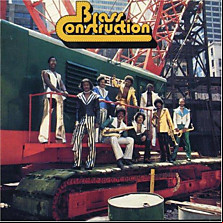BBC Review 1bj6o
The album was lyrically succinct and musically, monstrously funky.
Daryl Easlea 2009
In the year that punk was to galvanise jaded rockers everywhere, Brass Construction released an album that was to do the same for the soul community. Its mixture of driving rhythms and positive message showed there could be an alternative to disco that updated the work of Sly Stone and James Brown, while adding a new, urban flavour.
Bold, fresh and funky and loved by those in the know in the UK, Brass Construction set a template the group were to follow for the rest of their career. And what a template it was. If it could all be reduced to just one track, it would the album’s hit, Movin'. Its eight minutes of bright, propulsive repetition still sounds as fresh as a daisy.
Formed in the late 60s in Brooklyn as Dynamic Soul, the nine-piece group centred around British Guyana-born classically-trained flutist Randy Muller. With Jamaicans Wayne Parris and Michael Grudge in the band as well as Trinidadian Joe Arthur, the outfit blended African, Caribbean and American sounds into a tightly-locking rhythmic soul stew.
The album was lyrically succinct and musically, monstrously funky. The six tracks – Movin’, Peekin’, Changin’, Love, Talkin’ and Dance displayed (apart from a fear of using a ‘g’) how economical they could be with a groove. The brass section dominates, and the funky, James Brown-influenced rhythm work of guitarist Arthur keeps everything moving forward. Although technically not a ballad, Love takes the tempo down slightly and emphasises the social message that runs through the album.
With additional vocals by sisters Bonnie, Delores and Denise Dunning, Movin’ topped the US R&B chart, made the US pop Top 20 and the UK Top 30. Brass Construction made the UK Top 10 in March 1976. A much-loved album, its influence on the Britfunk movement (Light Of The World, Incognito, Level 42) of the late 70s and early 80s was immense.
